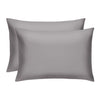The Daily Miracle
How To Sleep With Scoliosis: 6 Helpful Tips
Published
March 19, 2024
Author
Bridget Reed

Dealing with scoliosis at night often feels like trying to solve a puzzle where the pieces don’t quite fit. You twist and turn, trying to coax your spine into comfort, but it's like it has a mind of its own, bending through the thoracic or lumbar regions or maybe taking over your entire back.
Everyone has experienced nights where they can’t quite seem to find that one elusive spot where everything feels just right, but if you have scoliosis, this can be a more persistent concern. But hope is not lost.
With the right strategies, achieving better sleep and managing scoliosis pain is within reach.
What Is Scoliosis?
Scoliosis is a spinal condition that causes your spine to curve or bend in certain areas when it should instead be straight, the literal backbone of your body. Curves related to scoliosis can occur anywhere along your spine, but they’re most common around your thoracic (upper back) and lumbar (lower back) regions.
There are different types of scoliosis, like adolescent idiopathic scoliosis, which is the most common type and tends to show up during those growth-spurt years. Then there’s congenital scoliosis, born out of spinal malformations, and neuromuscular scoliosis, which is linked to conditions that affect muscle control.
No matter the type, they all have a similar effect when it comes to twisting the spine's normal alignment. The intensity of scoliosis varies, ranging from a mild annoyance to a severe, painful concern, and for some, it can even interfere with your ability to breathe.
Depending on the curve’s location and severity, it can lead to a cascade of effects, like uneven shoulders, one hip riding higher than the other, or even changes in how your rib cage sits. And let's not forget about the related concerns: back pain, neck pain, and, in more severe curves, difficulties with lung and heart function.
Scoliosis is a bit of a chameleon, sometimes making its presence known through visible signs or, other times, staying under the radar with more subtle hints. Regular check-ups and staying in tune with your body are key to keeping up with scoliosis and its shenanigans.
Navigating bedtime with scoliosis can be especially stressful because trying to align your body in a way that allows your unique spine to reach a neutral position can be a big challenge.
So, let’s talk about some helpful tips to ensure you get a good night’s sleep with scoliosis.
1. Use a Supportive Mattress
Locking down a mattress that understands your unique spinal needs, embraces them, and gives you the support you need to sleep well is key to getting a better night’s rest. You’ll want something firm yet forgiving, enabling your mattress to evenly distribute your weight without causing you pain by forcing your spine’s individual curves in a direction they don’t want to go.
A firm mattress may cause problems, while a soft mattress can really wreak havoc on the spinal curvature of scoliosis patients. So, you’ll want a happy medium to get the best sleep possible.
Memory foam mattresses and toppers are ideal for this purpose. These wonders work by adapting to your body’s shape, offering tailored support that encourages your spine to settle into a neutral, happy place without being too firm and rigid.
It’s about finding that perfect balance where your back feels supported, cradled, and ready to dive into a deep, restorative sleep, all while keeping the aches and twinges at bay.
2. Choose the Right Pillow
Finding the right pillow is like hitting the jackpot for keeping your spine happy, especially if scoliosis is part of your nightly equation. A cervical pillow, tailored to cradle the natural arc of your neck, acts as a critical ally in keeping your entire spine lined up just right.
This can also help to address pain between your shoulder blades and help with pain relief if this is a common occurrence for you.
For those of us who are side sleepers, it's all about making sure that the pillow bridges the gap between your head and the mattress, keeping your neck and spine as straight as an arrow. And let’s not forget the importance of material here.
As with your mattress, memory foam options are top-notch, adjusting to the contours of your neck and offering personalized support. No matter what kind of pillow you use, it’s important to also use a high-quality pillowcase like our Luxury Pillowcases.
Infused with antimicrobial silver, they’ll help to keep your bedding cleaner longer by cutting down on bacterial growth.
3. Sleep in a Back-Friendly Position
Zeroing in on the best sleeping positions can significantly impact those with scoliosis, aiming for either back or side sleeping to hit that sweet spot of comfort and support. Laying on your back does wonders, spreading your body weight evenly across the widest surface of your body, allowing for optimal spinal alignment.
But if the back isn’t where your comfort lies, turning to your side, particularly the right rather than your left, might just be your next best bet. This position can lighten the load on your spine, offering relief and promoting spinal health.
However, stomach sleeping is the one to avoid, as it is notorious for nudging back pain and throwing spinal alignment out of whack.
4. Maintain a Cool, Comfortable Sleeping Environment
The setting for your slumber plays a big part in how well you snooze. Keeping your sleep sanctuary cool and comfy is crucial; think of it as setting the stage for restful sleep.
Opt for breathable bedding to prevent any heat buildup and keep your bedroom temperature just right — cool enough to ward off any unwanted sweat but cozy enough to snuggle down. Our Miracle Made® Comforters are ideal for keeping you cozy while maintaining an ideal sleep temperature throughout the night.
A tranquil atmosphere, dim lights, and a dash of quiet complete the recipe for a sleep-conducive environment, letting you drift off without a care in the world and enabling you to experience deeper sleep.
5. Establish a Relaxing Bedtime Routine
Crafting a bedtime ritual is like sending a VIP invite to the Sandman. Engaging in calming activities as you wind down — be it losing yourself in a book, stretching out the day’s kinks, or floating away on the notes of soothing tunes — can significantly signal your body it's time to hit the hay.
For those navigating the curves of scoliosis, this routine isn’t just nice to have — it’s a cornerstone for coaxing your body into a state of relaxation, paving the way for a night of deeper, more restorative sleep.
6. Consider Stretching or Gentle Yoga Before Bed
Incorporating a session of gentle stretching or yoga before bedtime can offer a world of relief for those wrestling with scoliosis. These movements can ease muscle tension, boost flexibility, and dial down discomfort, making the quest for a comfy sleeping position less of a hurdle.
While it’s important to speak to your professional if you’re looking into chiropractic or physical therapy options for scoliosis treatment, as long as they think it’s safe, this kind of light exercise can really help to address scoliosis symptoms while you sleep.
The Bottom Line
Scoliosis can undoubtedly affect sleep, but it doesn't have to dictate the quality of your rest. By adopting the right sleeping practices, from choosing a supportive mattress and the proper pillows to finding the best position for your unique curvature, you can achieve better sleep and manage scoliosis pain more effectively.
Sources:
Scoliosis And Bronchial Obstruction | National Library of Medicine
How To Manage Low Back Pain Before It Gets Worse | NIH Medline Plus





























